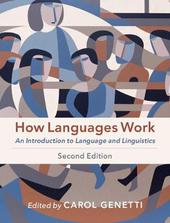
|
How Languages Work: An Introduction to Language and Linguistics
Hardback
Main Details
| Title |
How Languages Work: An Introduction to Language and Linguistics
|
| Authors and Contributors |
By (author) Carol Genetti
|
| Physical Properties |
| Format:Hardback | | Pages:704 | | Dimensions(mm): Height 252,Width 193 |
|
| Category/Genre | Language - reference and general
linguistics |
|---|
| ISBN/Barcode |
9781108470148
|
| Classifications | Dewey:400 |
|---|
| Audience | | Tertiary Education (US: College) | | Professional & Vocational | |
|---|
| Edition |
2nd Revised edition
|
| Illustrations |
Worked examples or Exercises
|
|
Publishing Details |
| Publisher |
Cambridge University Press
|
| Imprint |
Cambridge University Press
|
| Publication Date |
8 November 2018 |
| Publication Country |
United Kingdom
|
Description
Language is a sophisticated tool which we use to communicate in a multitude of ways. Updated and expanded in its second edition, this book introduces language and linguistics - presenting language in all its amazing complexity while systematically guiding you through the basics. The reader will emerge with an appreciation of the diversity of the world's languages, as well as a deeper understanding of the structure of human language, the ways it is used, and its broader social and cultural context. Part I is devoted to the nuts and bolts of language study - speech sounds, sound patterns, sentence structure, and meaning - and includes chapters dedicated to the functional aspects of language: discourse, prosody, pragmatics, and language contact. The fourteen language profiles included in Part II reveal the world's linguistic variety while expanding on the similarities and differences between languages. Using knowledge gained from Part I, the reader can explore how language functions when speakers use it in daily interaction. With a step-by-step approach that is reinforced with well-chosen illustrations, case studies, and study questions, readers will gain understanding and analytical skills that will only enrich their ongoing study of language and linguistics.
Author Biography
Carol Genetti is a Professor of Linguistics and the Anne and Michael Towbes Graduate Dean at University of California, Santa Barbara. She is a specialist in Himalayan languages and in the documentation and description of previously undescribed languages. Her Grammar of Dolakha Newar (2007) was awarded the inaugural Von der Gabelentz book award from the international Association for Linguistic Typology. She has published numerous articles, especially on the syntax of clause combining in Tibeto-Burman languages, but also on phonology, morphology, syntax, discourse, typology, grammaticalization, grammar writing, and historical linguistics. In addition, Professor Genetti has a strong interest in the documentation and conservation of endangered languages. She was founding Director of the Institute on Field Linguistics and Language Documentation (InField/CoLang) and Chair of the Committee on Endangered Languages and their Preservation.
Reviews'Genetti's and the contributing authors' careful consideration of and attention to the reader's needs make for a highly engaging and comprehensive revised volume which goes well beyond constituting just another introductory textbook in the field. The volume is most readable, providing a solid, up-to-date understanding in chapters which span the full scope of expected areas.' Martin Howard, University College, Cork 'This is an excellent text, novel in its approach to the study of language. It assumes no prior knowledge, provides a step-by-step guide to the building blocks of language, with up-to-date examples from across the globe. Other features of the text, such as the sidebars, stop-and-reflect boxes, wireless icons, and instructions for tutors and students alike, are like goodies in a toolbox for both the initiates and novices to this complex area of human communication.' Ayo Amuda, University of South Wales 'This impressive textbook comprises carefully dovetailed chapters by renowned linguists, combining introductions into numerous subfields with discussions of current controversies from a typological perspective. Both beginners and advanced students are catered for with a wide range of language profiles and exercises.' Florian Haas, Friedrich-Schiller-Universitat Jena 'The biggest strength of this book is that it greatly improves students' analytical skills through an abundance of interesting data from a variety of languages.' Eva Kardos, University of Debrecen 'How Languages Work captures the joy of linguistics by immersing readers in data from an amazing array of languages. Innovative exercises use online resources to introduce the linguistic world outside the classroom.' Clifton L. Pye, University of Kansas '... the book seems to cover its goals since each chapter of the first part explains explicitly the linguistic principles and structures and encourages students to apply methods in order to better perceive a linguistic phenomenon. Also, by reading the second part of the book, students will be able to observe different grammatical structures in different languages of the world and understand the linguistic diversity.' Georgios P. Georgiou, LINGUIST List
|